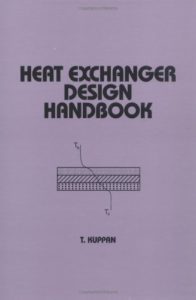Heat Exchanger Design Handbook
Heat Exchanger Design Handbook
Heat Exchanger Design Handbook covers all the important aspects of heat exchangers (HEs)–their design and modes of operation–and practical, large-scale applications in process, power, petroleum, transport, air conditioning, refrigeration, cryogenics, heat recovery, energy, and other industries. Reflecting the author’s extensive practical experience in industry, the Heat Exchanger Design Handbook discusses standard construction, thermo-hydraulic fundamentals and thermal design of Hes–tubular, extended surface, plate, and both rotary matrix and fixed regenerators explains algorithms and sub algorithms derived from heat transfer and geometry optimization modules showcases the tremendous recent advances in plate exchanger designs–brazed-plate, flow-flex tubular, wide gap, twin plate, double wall, graphite, and welded
You can also Read Advances in Thermal Design of Heat Exchangers
contents :
Cover
Preface
Contents
1.Heat Exchangers-Introduction, Classification, and Selection
2.Heat Exchanger Thermo hydraulic Fundamentals
3.Heat Exchanger Thermal Design
4.Compact Heat Exchangers
5.Shell and Tube Heat Exchanger Design
6.Regenerators
7.Plate Heat Exchangers and Spiral Plate Heat Exchangers
8.Heat-Transfer Augmentation
9.Fouling
10.Flow-Induced Vibration of Shell and Tube Heat Exchangers
11.Mechanical Design of Shell and Tube Heat Exchangers
12.Corrosion
13.Material Selection and Fabrication.
14.Quality Control and Quality Assurance, Inspection, and Nondestructive Testing
15.Heat Exchanger Fabrication
References
Index
.associated improvements addresses global and national standards and codes analyzes flow-induced vibration and mechanical design of shell-and-tube Hes explores a wide spectrum of materials for HEs, corrosion behavior, and optimum fabrication methods illustrates techniques for fabrication of shell-and-tube HEs, as well as brazing and soldering compact HEs examines quality assurance issues for HE manufacture and NDT techniques considers operational problems like corrosion and fouling and more! Abundantly illustrated with over 400 drawings, diagrams, tables, and equations, the Heat Exchanger Design Handbook is an excellent resource for mechanical, chemical, and petrochemical engineers; process equipment and pressure vessel designers; and upper-level undergraduate and graduate students in these disciplines.”

Comments are closed.